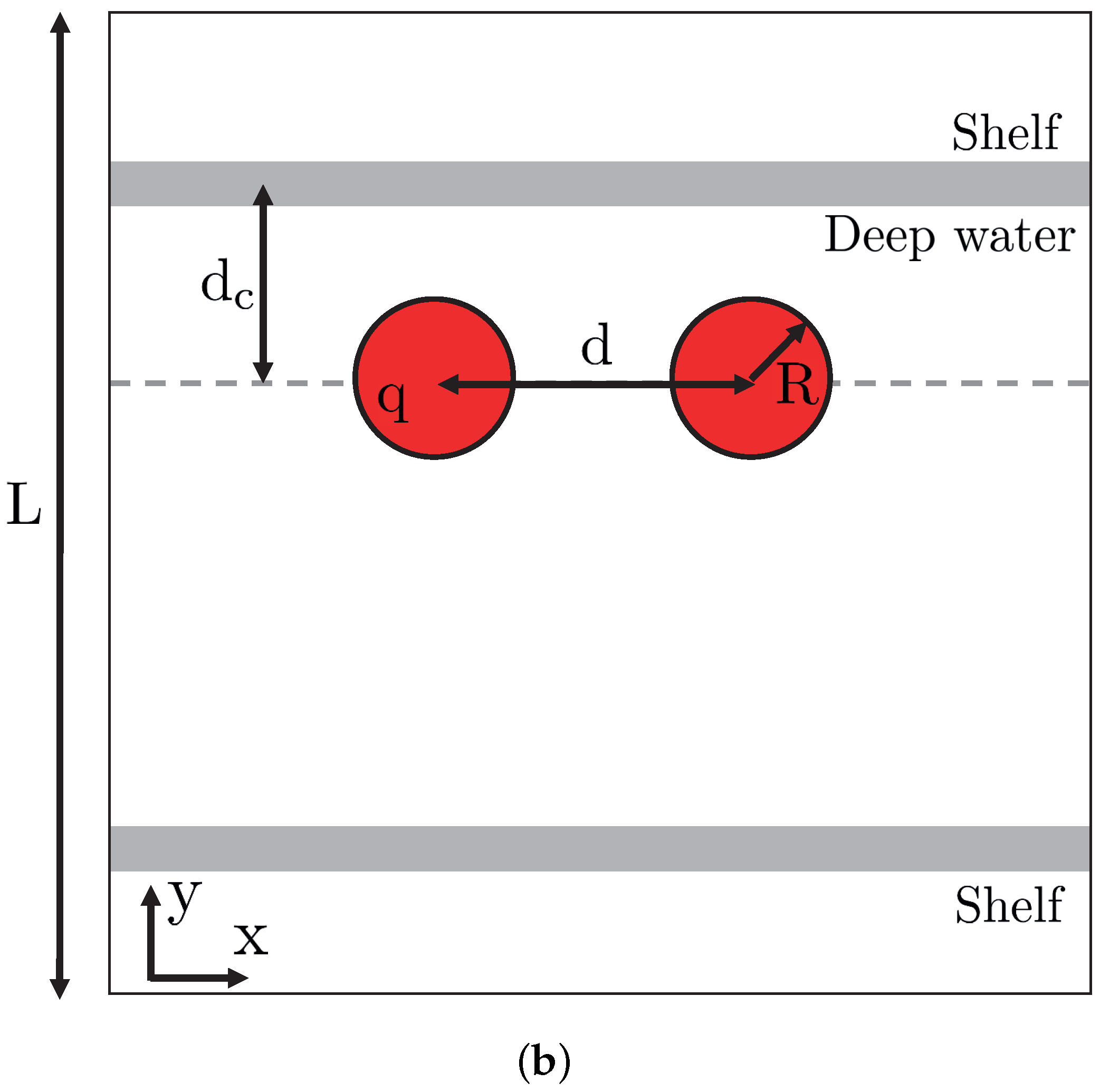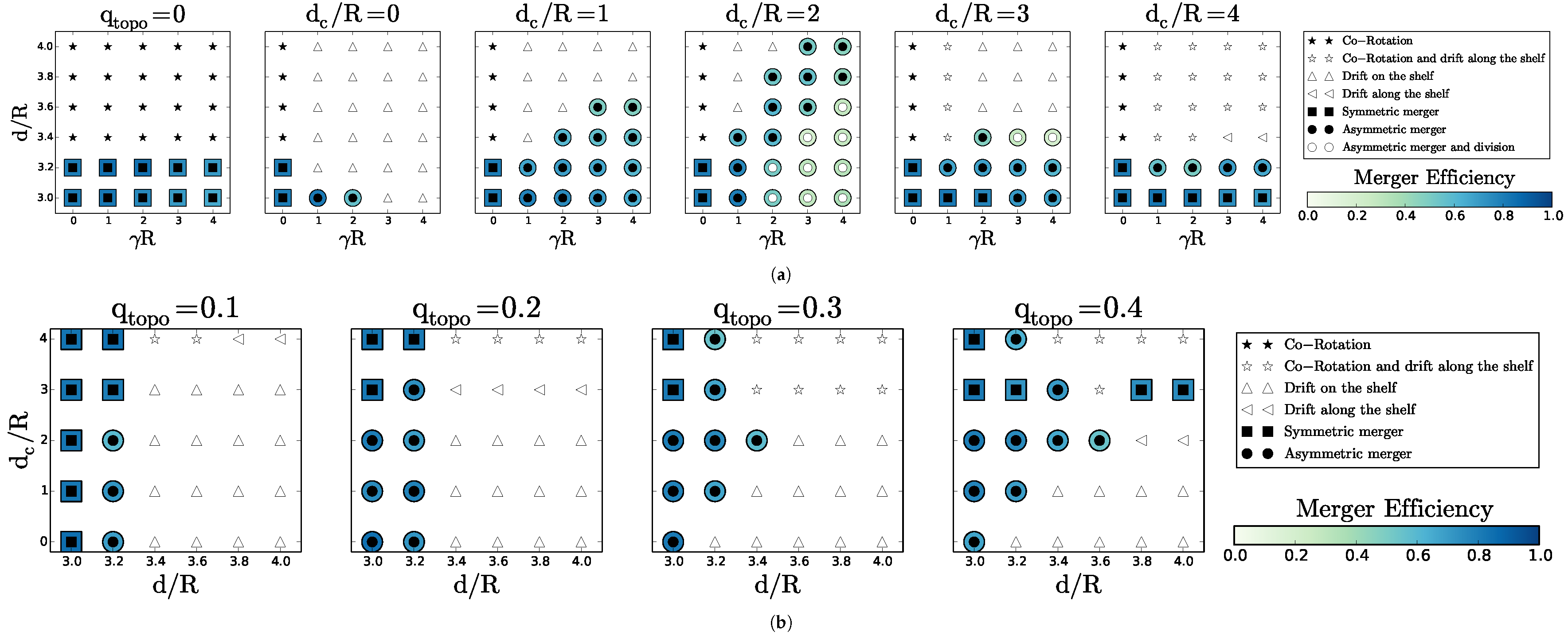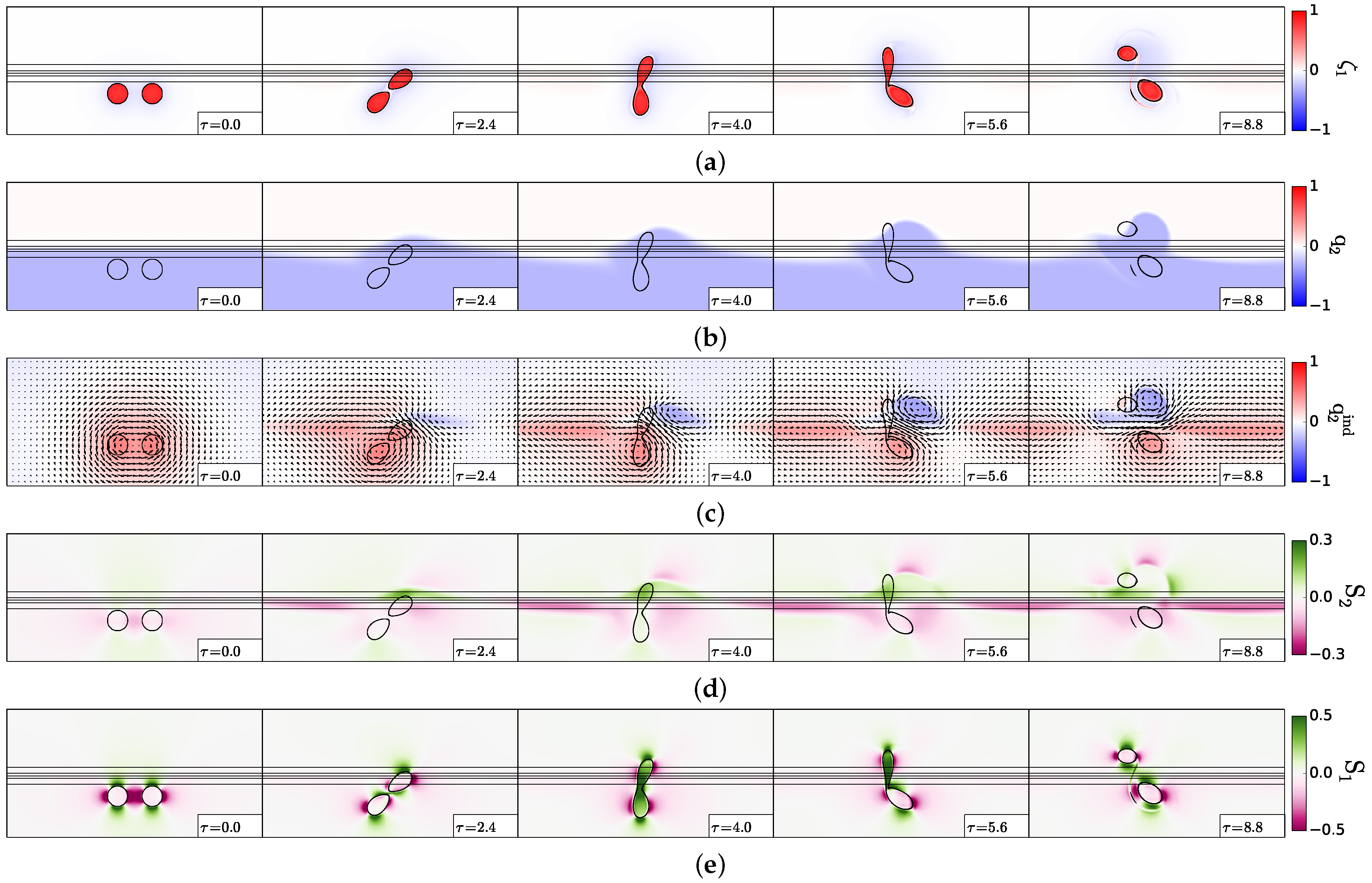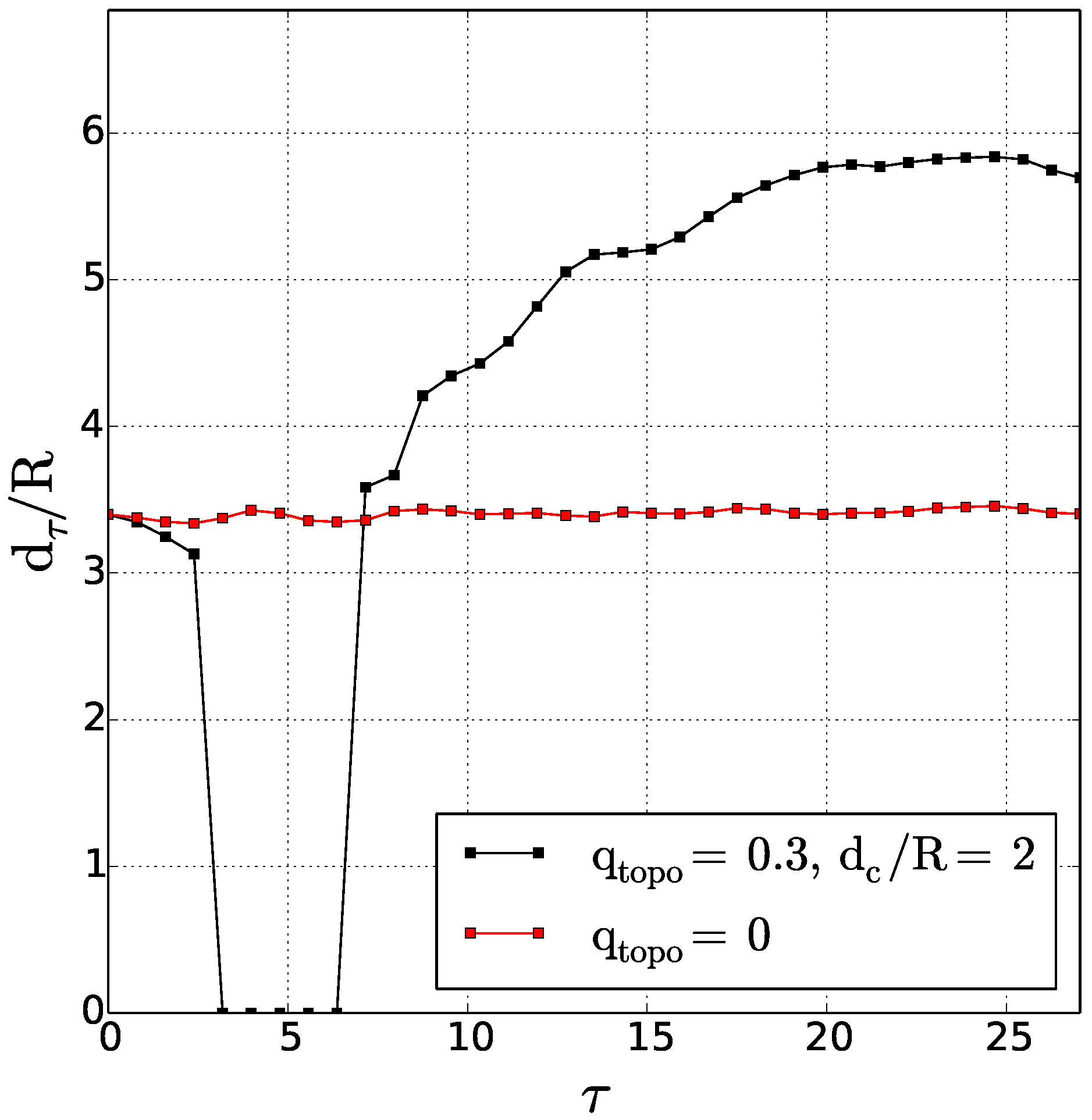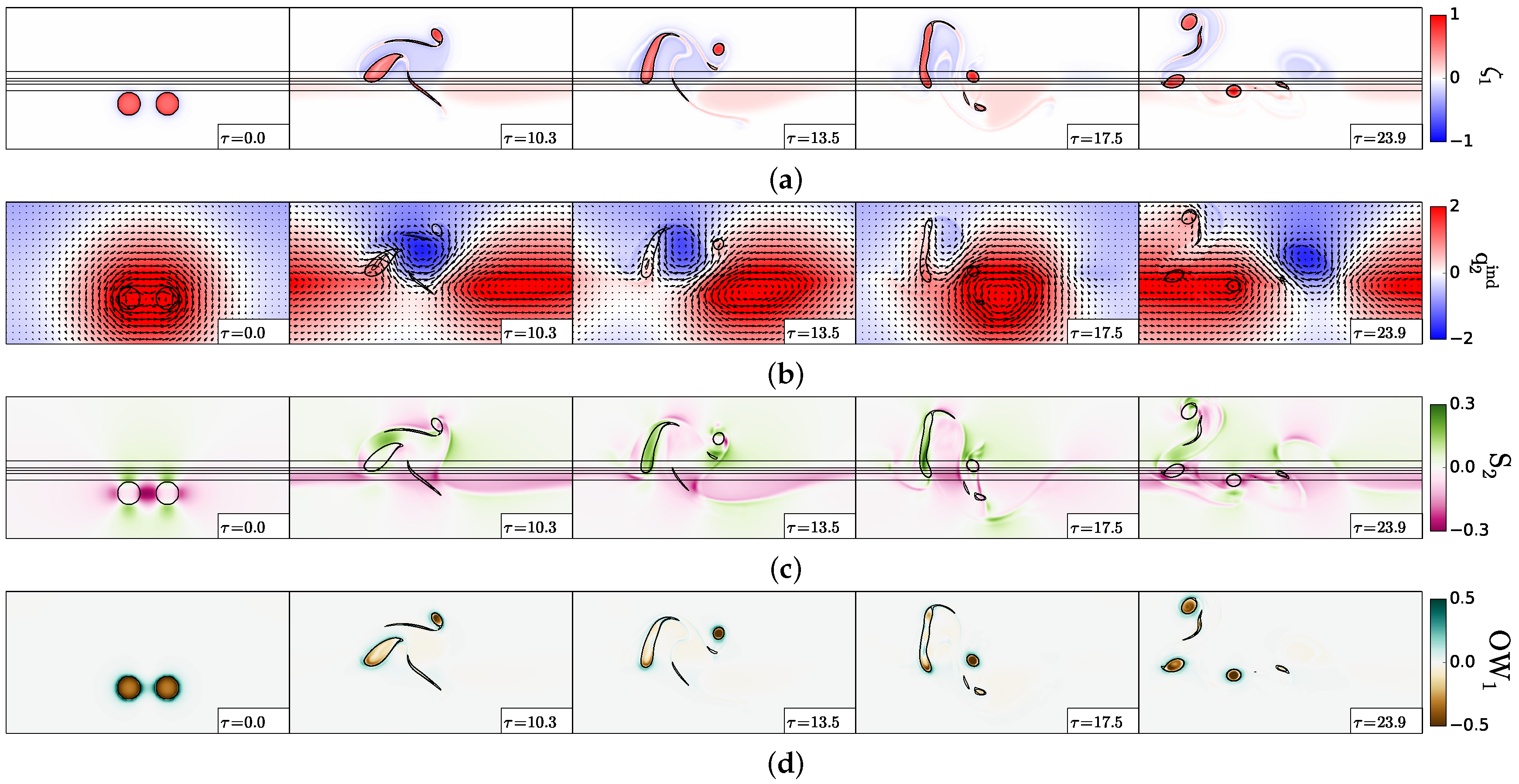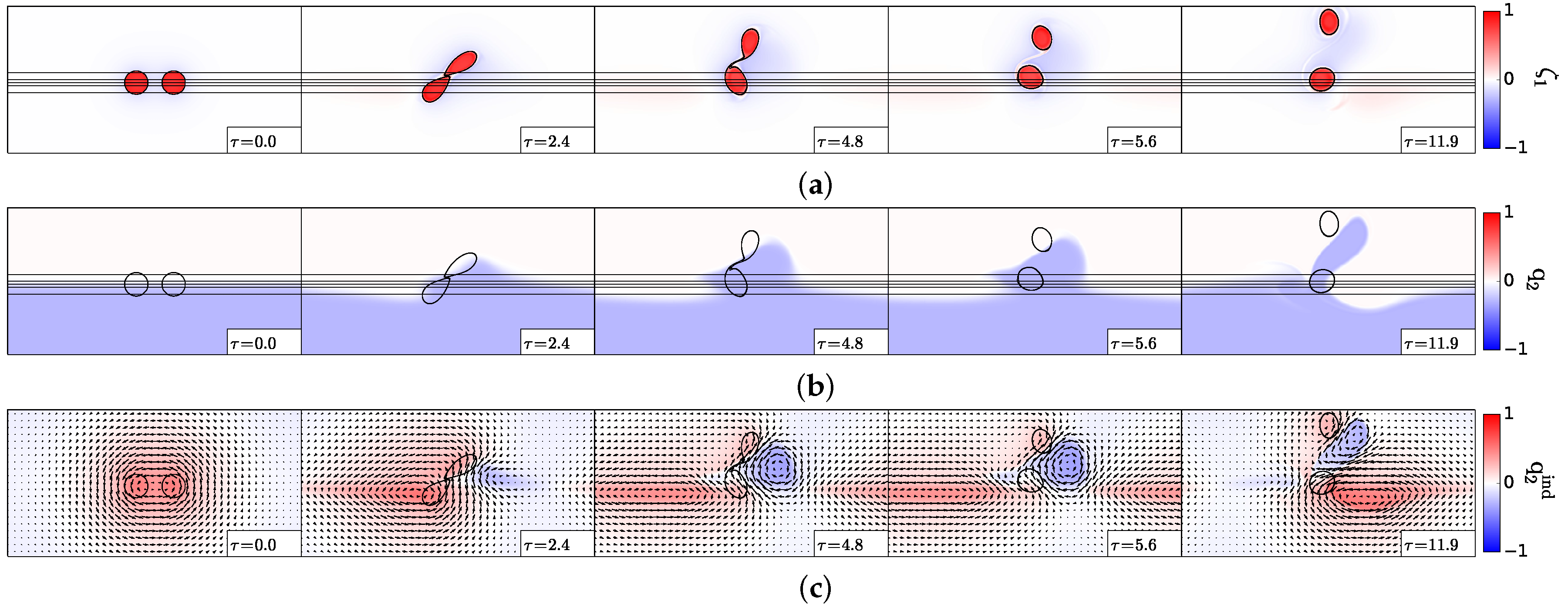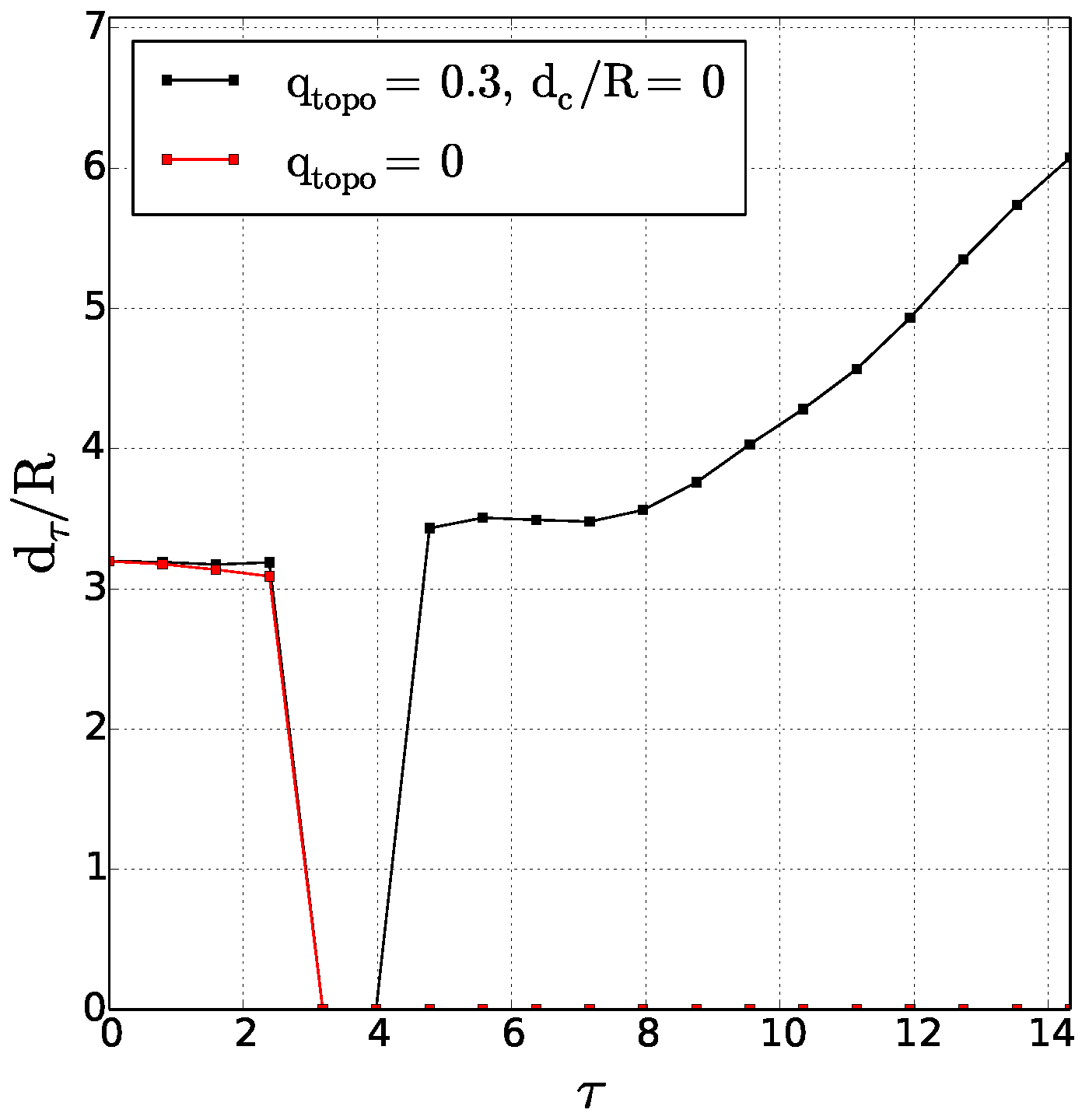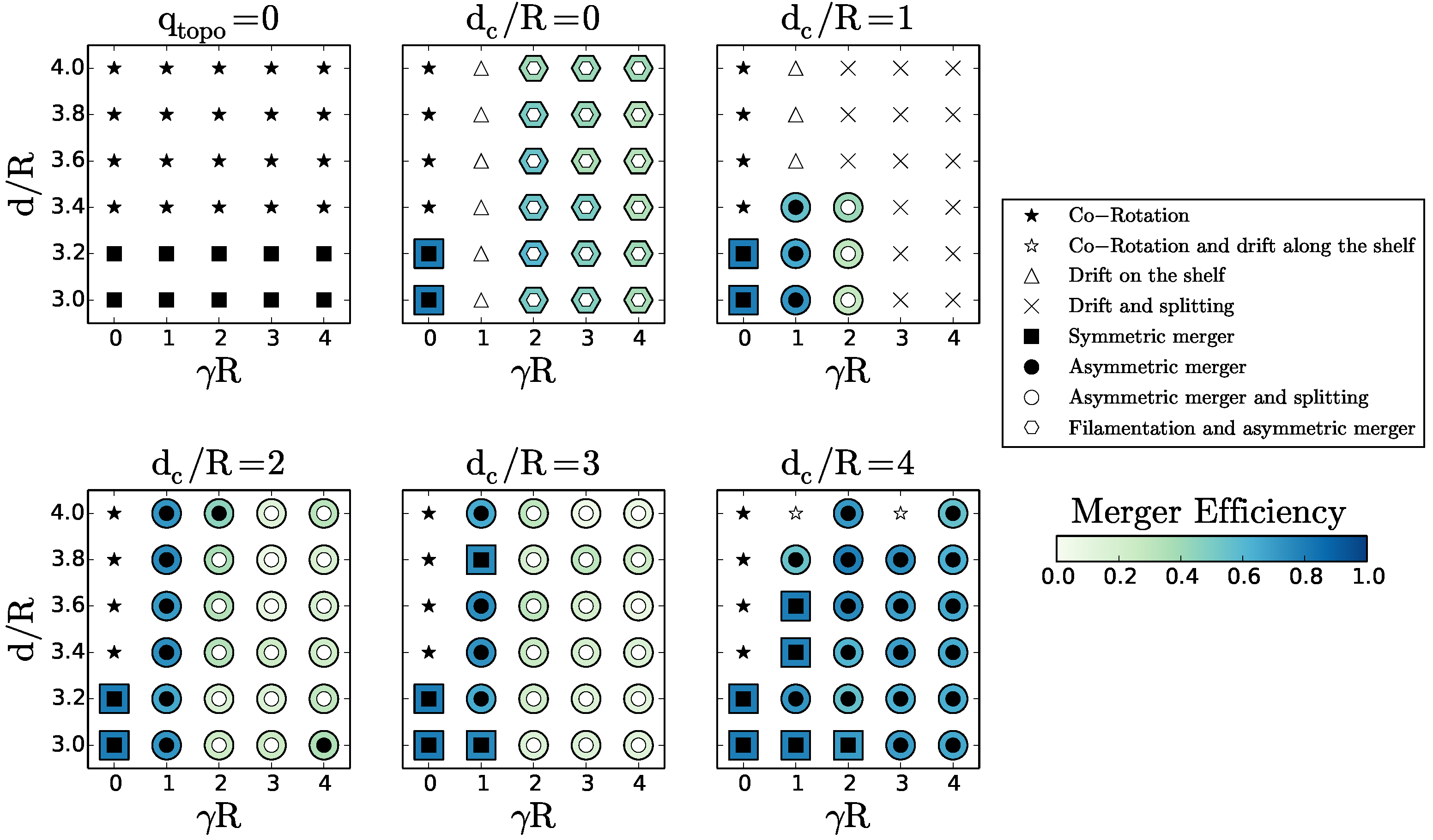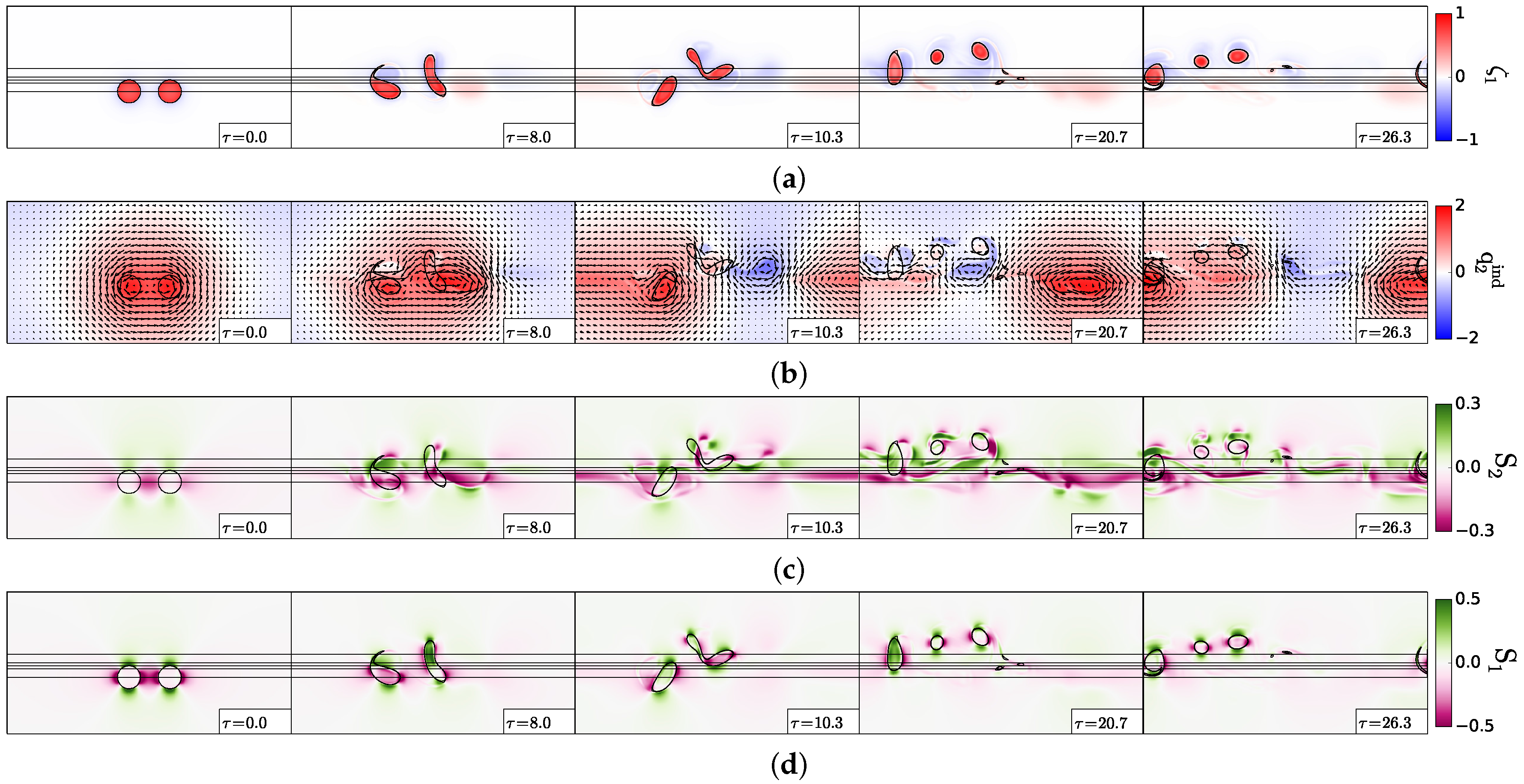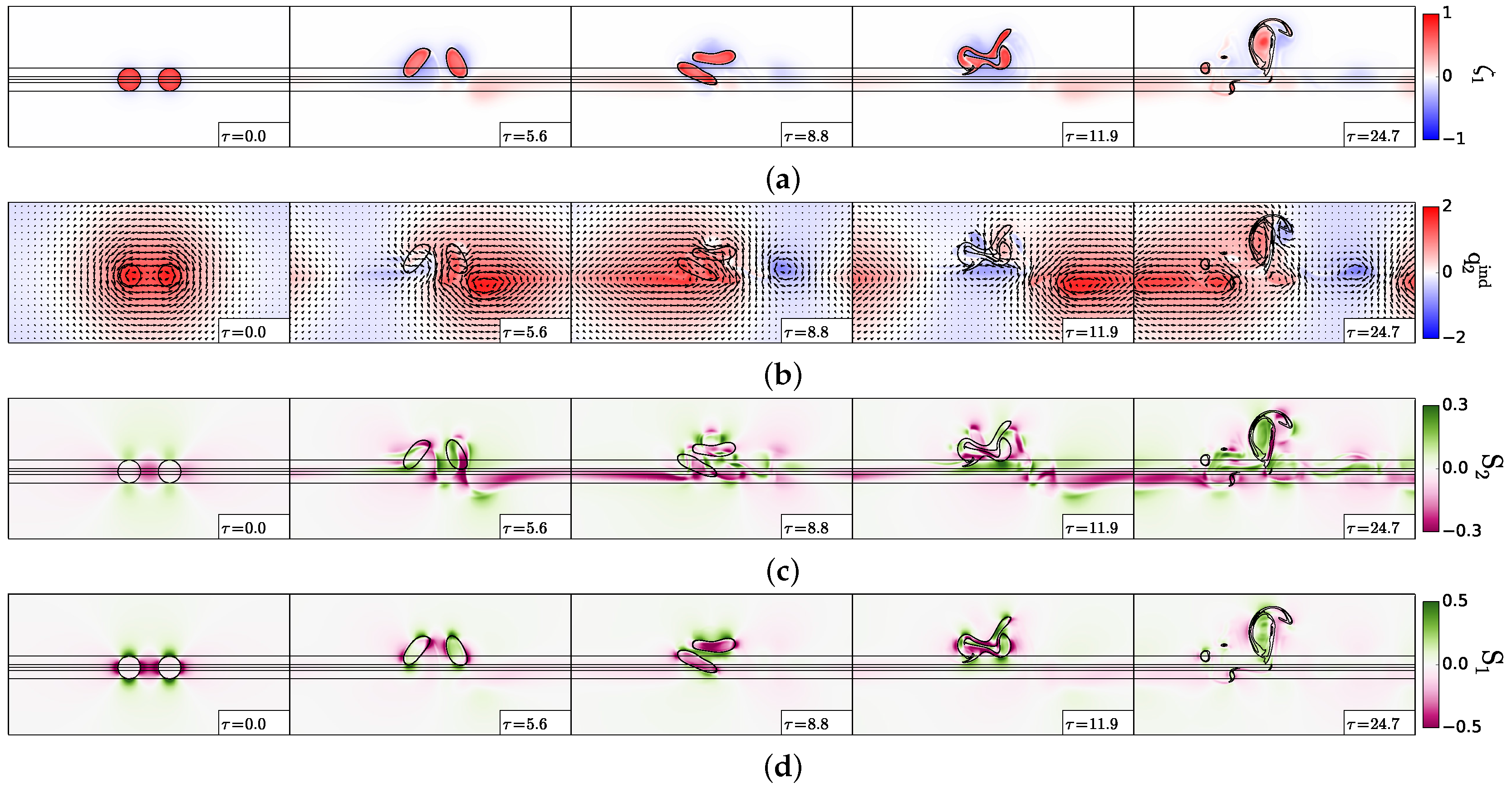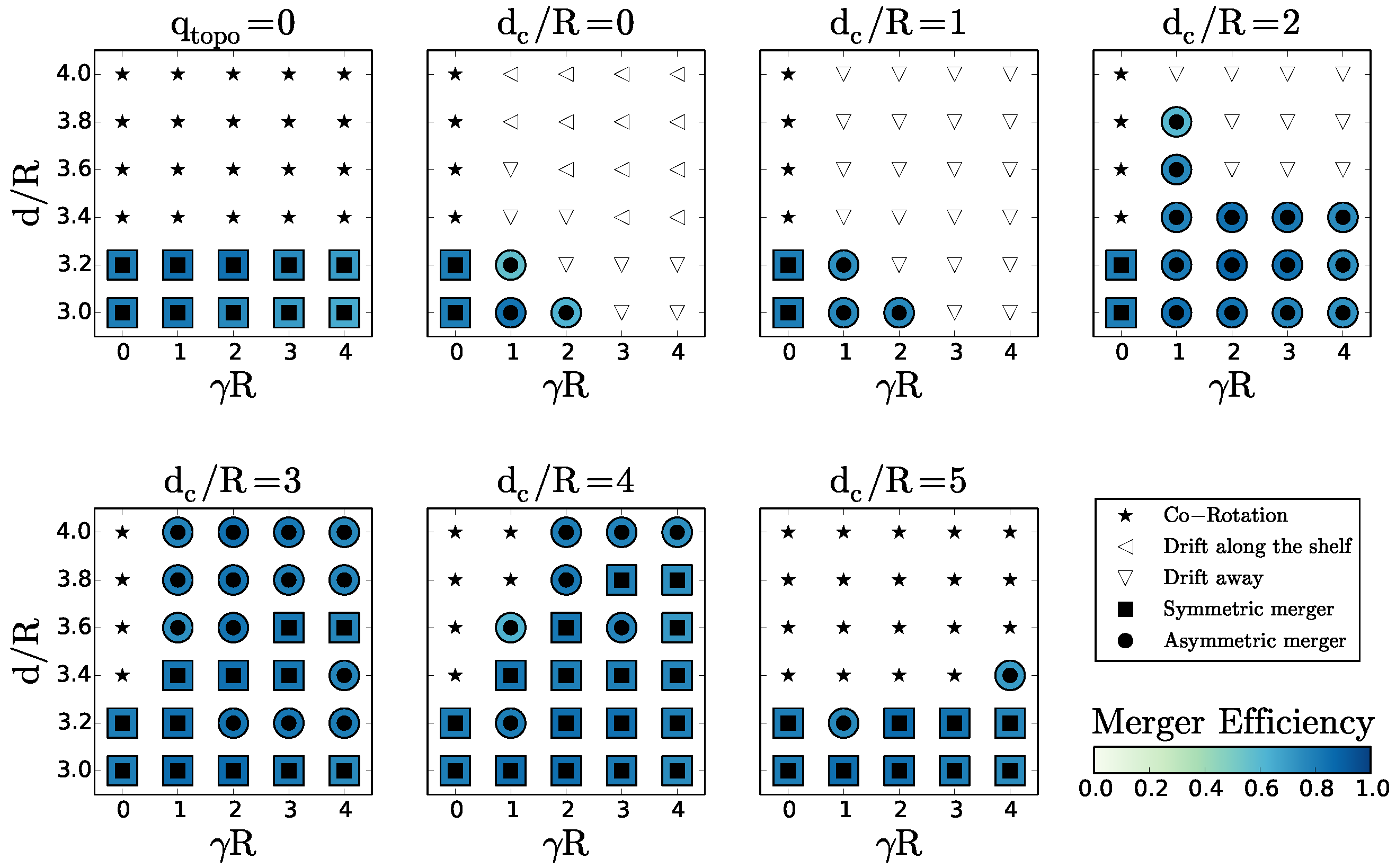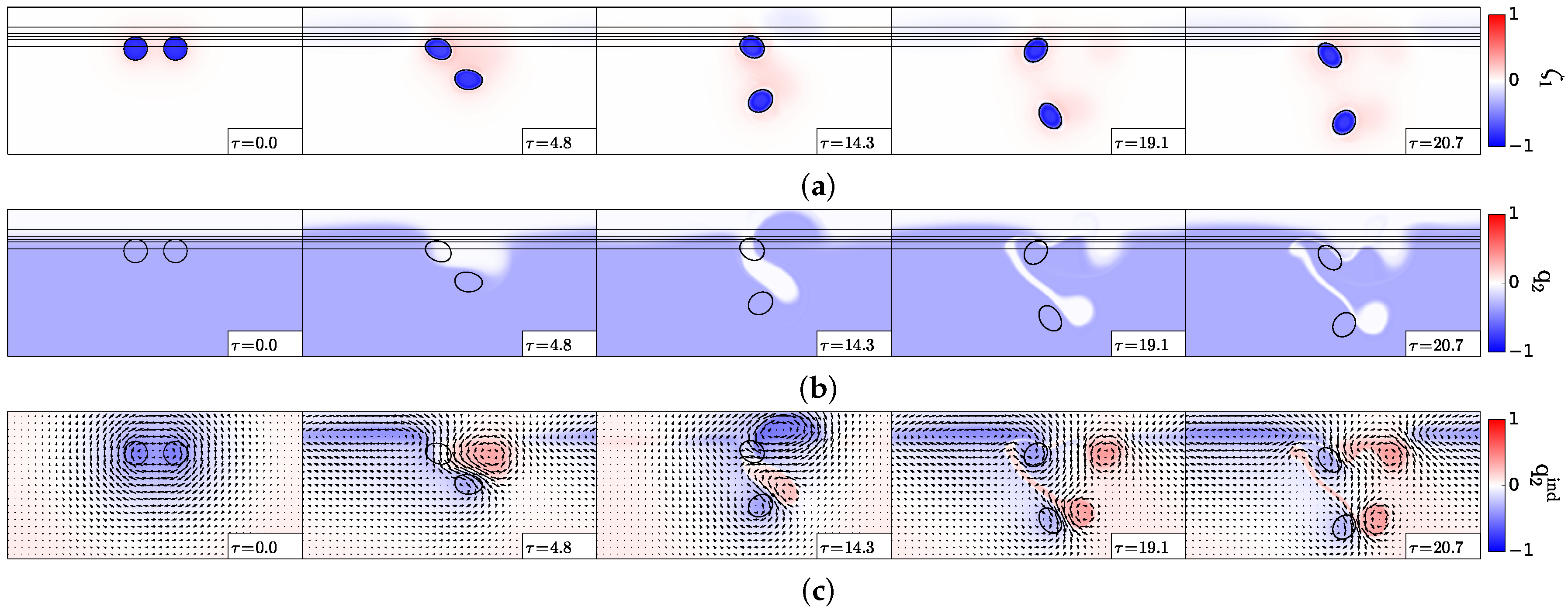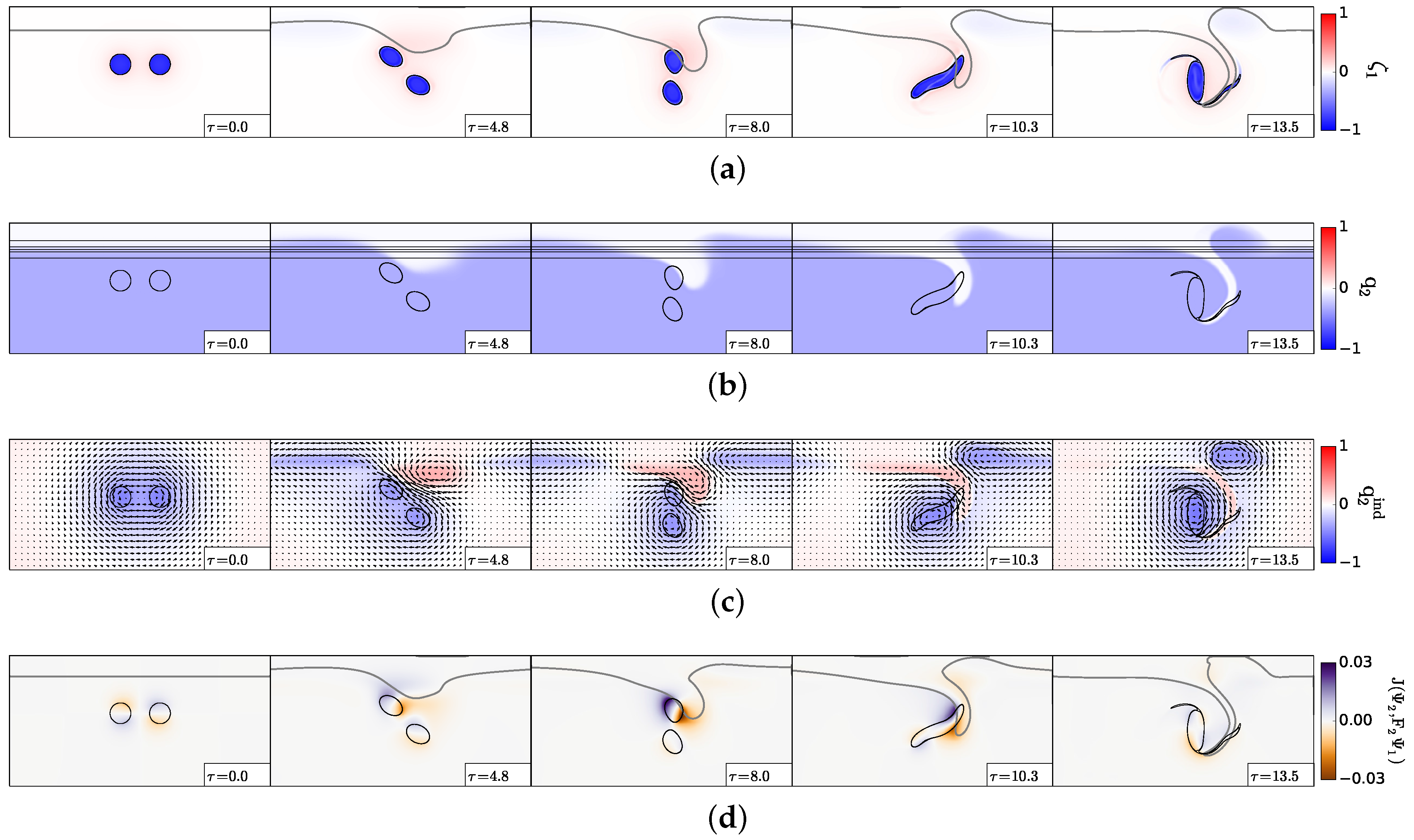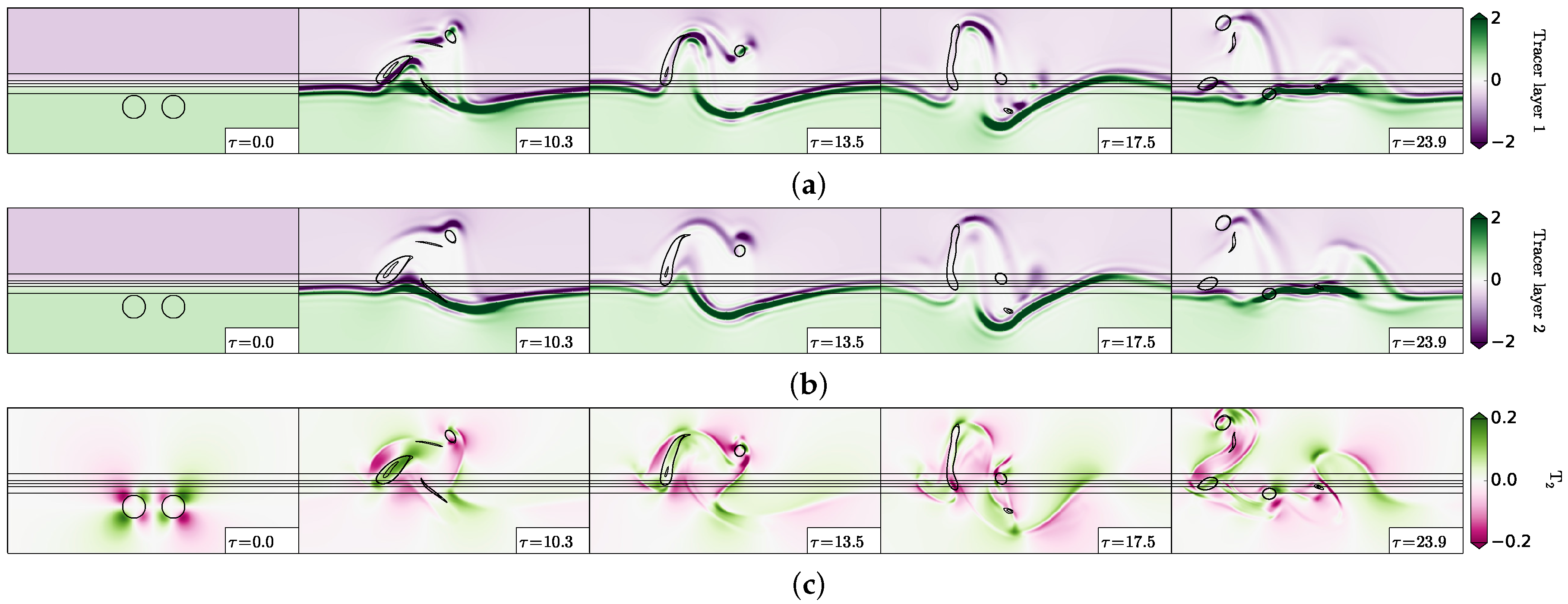1. Motivation of the Study
Vortices are prevalent and long-lived features of ocean dynamics. They play a key role in the transport of momentum, heat, salt, chemical tracers and biological species, across the ocean basins. They can be surface intensified, like the warm-core rings of the Gulf Stream, or thermocline-intensified vortices, like meddies (eddies of Mediterranean outflow water) in the Northeastern Atlantic Ocean [
1]. Oceanic vortices can exist both at the mesoscale (with radii comparable to the first internal deformation radius) and at the submesoscale (with smaller radii; [
2]). Vortices can be generated at the submesoscale and then merge to grow in size to the mesoscale [
3]). The merging process is that by which two like-signed vortices, at the same depth, collapse to form a larger vortex. Vortex merger has been observed in the ocean for Gulf Stream rings [
4] and also for meddies [
5,
6,
7].
The process of vortex merger has been studied in simple configurations; the evolution of two equal vortices, or of two unequal vortices, with initially axisymmetric velocities, in the absence of external currents, has been investigated in two-dimensional incompressible flows [
8,
9,
10,
11,
12,
13,
14,
15,
16] and in rotating, stratified flows [
17,
18,
19,
20,
21,
22,
23,
24,
25,
26]. In these studies, the two vortices interacted in the absence of bottom topography.
Interactions of like-signed oceanic vortices have also been observed near coasts.
Figure 1 shows the interaction of two anticyclones near the east coast of Australia.
In such a case, each vortex not only interacts with its partner, but also with the coastal bathymetry.
The interaction of a single vortex with a topographic step has already been studied. McDonald [
27] showed that cyclones are drawn towards the shallow region (also called “the shelf” hereafter) and that anticyclones are repelled away from it, into the deep region. Indeed, a cyclone (referred to as a “primary cyclone” hereafter) advects fluid from offshore onto the shelf to its right and shelf fluid offshore to its left. The former fluid column is squeezed vertically and develops anticyclonic relative vorticity, while the latter is stretched vertically and becomes cyclonic. These fluid columns, which have acquired vorticity, are called “secondary vortices”. The flow field created by this secondary dipole advects the primary cyclone shoreward (see also Figure 2a of [
28]). The opposite effect holds for anticyclones, which are advected offshore by these secondary vortices. Dunn et al. (2001) [
29] showed that, for a tall topographic step, vortices can drift with the topographic wave in a steady motion. Zhang et al. (2011) [
30] also studied the transport of shelf water, associated with the topographic wave-vortex interaction. They found that the topographic vortex created by a cyclone remains near the shelf, while that created by an anticyclone couples with it and moves offshore; therefore anticyclones are more capable of advecting water away from the shelf. It has been shown that the interaction of ocean vortices with the bottom slope can produce smaller (submesoscale) vortices by forcing and then destabilising a bottom boundary layer [
31,
32].
Vortex merger near a topographic step in a stratified fluid has however not yet been addressed. This process raises several questions:
- (1)
Under which conditions can two surface vortices merge near a topographic step or slope?
- (2)
What are the other nonlinear regimes they can undergo and why?
- (3)
What are the consequences of these various interactions on the cross-shelf transport?
This problem is complex due to the number of parameters involved (vortex radius, intensity, mutual distance of the vortices, distance to the shelf, topographic slope, height of the shelf, planetary beta effect). Here, we reduce the problem to a simple configuration to render it tractable. We consider two vortices, with piecewise uniform potential vorticity, in a two-layer quasi-geostrophic model on the f-plane. The slope is a hyperbolic tangent in the meridional direction.
The paper is organised as follows:
Section 2 presents the methods and models.
Section 3 describes the various nonlinear regimes for the interaction of two cyclones.
Section 4 analyses these regimes and the influence of topographic height.
Section 5 is devoted to the interaction of two anticyclones.
Section 6 addresses the evolution of tracer and particles in the flow field and their exchange across the slope. Finally, conclusions are presented in
Section 7.
2. The Mathematical Model
2.1. Model Governing Equations
The quasi-geostrophic equations govern the dynamics of stratified flows strongly constrained by planetary rotation (flows with small Froude and Rossby numbers) and with moderate meridional extent. Denoting U the horizontal velocity magnitude, L the horizontal length scale, H the thickness of the flow, N the buoyancy frequency, the Coriolis parameter in the domain (at any latitude) ( being the Coriolis parameter at the centre of the domain, y the meridional distance to this centre, the meridional gradient of the Coriolis parameter), the Froude number is , the Rossby number is and the meridional extent of the flow, L, is bounded by .
In a fluid composed of two superimposed layers of uniform (but different) densities, these quasi-geostrophic equations are written:
where
is the upper, lower layer index. The right-hand side of Equation (
1) is the biharmonic dissipation of vorticity, implemented numerically to remove vorticity accumulation at small scales, and
is called hyperviscosity. The layer-wise total potential vorticity is:
where
is the stream function in layer
j. We used
.
Due to the small meridional extent of the domain considered in this study, we keep here. The layer coupling coefficients are with the thickness of layer j and the reduced gravity. is an average density, and is the Kronecker symbol. The internal deformation radius is , and its inverse is called . Here, equal layer thicknesses are chosen . The two-layer model is appropriate for surface-intensified flows in the ocean (Flierl, 1978).
The topographic height (from the deepest bottom) is
here (see its mathematical form in
Section 2.2; note that the choice of direction for the topographic gradient is arbitrary with respect to the f-plane). The relative vorticity is:
the horizontal velocity being:
From this velocity, we can define the velocity shear in layer
j:
the strain rate in layer
j:
and finally the Okubo–Weiss quantity:
It distinguishes regions where deformation is dominant from those of concentrated vorticity.
We remind that the vertical (barotropic and baroclinic) modes are defined by:
For convenience, we call:
the potential vorticity anomaly (note that
).
We call topographic vorticity the term:
In our analyses, we use the quantity:
that we call the “equivalent barotropic” potential vorticity of the lower layer. From this quantity, the lower layer stream function (velocity) can be directly diagnosed (by inverting a Helmholtz operator).
2.2. Numerical Model
Equations (
1) and (
2) for the quasi-geostrophic model have been implemented numerically in a square, biperiodic domain, using a pseudo-spectral technique in space and a mixed Euler-leapfrog scheme in time. The time step is bounded by the Courant–Friedrich–Levy condition,
. The domain length and width used are
(with
). Model simulations are performed with 512 collocation points. Very weak biharmonic viscosity is applied in the model (
). This viscosity does not alter the physical results of the model and only removes small-scale noise.
The initial conditions of this model are a pair of identical, circular vortices of radius
, enclosing uniform quasi-geostrophic relative vorticity
(when we investigate the interaction of two cyclones) or
(when we study the interaction of two anticyclones), lying at a distance
d from each other and at a distance
from the topography. Elsewhere,
(see
Figure 2).
As an application to the ocean, the East Australian eddies have a peak velocity at a radius km. Using an estimate of vorticity s, length and time are scaled between the model and the ocean via and . At 35 S, , so that (note that ). The radius of deformation is about 50 km so that the Burger number . The relative influence of the beta-effect is weak, since the vortices are mesoscale features; here, , and the vortex radius is small compared with the Rhines scale , a scale above which the beta effect is influential on the dynamics. Here, km.
In the model, the dimensionless value of
is therefore
, which scales the topographic vorticity
in Equation (
3). The maximal value of
, used in this study is
. Note that the quasi-geostrophic model assumptions are met since the Rossby number is small, the Burger number is unity, the beta effect is weak and the topographic amplitude remains moderate.
Nevertheless, this validity is limited to mesoscale vortices, near low shelves, at mid-latitudes. The interaction between smaller vortices, near taller shelves, should be investigated in a primitive equation model.
The bathymetry is a smooth slope both north and south (for positive and negative
y’s):
The topographic gradient thus defines the meridional direction. The choice of parameter values for cyclonic solutions is and for anticyclones. The shallow region is wider in the former case, because cyclones tend to climb on topographic slopes; therefore, a significant part of their evolution is expected to take place in the shallow region (the “shelf”), if they are not too far away from it initially. Due to meridional periodicity of the domain (the isobaths giving the zonal direction), the shelf forms a single region.
To track fluid masses, a passive tracer, with initial distribution equal to one over the shelf and to minus one in the deep region, is used to study the evolution of shallow and deep fluid masses. Note that the passive scalar field has the same resolution and undergoes the same dissipation as vorticity.
Furthermore, 10,000 particles were seeded in the flow (over the shelf, in the deep region and in the vortices). Their advection (via a Euler scheme) and tracking allow us to follow the fluid from the vortex cores.
3. Interaction of Two Cyclones: Nonlinear Regimes
Three hundred numerical simulations have been performed varying the non- dimensional distance between the two cyclones
, their distance to the slope
, the rescaled density stratification
and the topographic vorticity
.
Figure 3 summarises the main regimes in the parameter space.
The left-hand panel in
Figure 3a is similar to the results obtained by Polvani (1989) [
33], for vortex merger over a flat bottom in a two-layer quasi-geostrophic model: in this case, merger occurs for
. The invariance of the nondimensional critical merger distance
with respect to stratification in this study is related to the vortex initialisation as a disk of constant potential vorticity. When vortices are initially disks of uniform relative vorticity, the critical merger distance depends on stratification via hetonic effects [
18,
19,
34,
35,
36,
37]. Indeed, relative vorticity in one layer induces interface deviation between layers and thus potential vorticity of opposite sign in the other layer. This in turn can lead to vertical coupling of these vorticity poles and to their self-advection, counter-acting the merging process.
In the presence of topography, the two cyclone evolution is similar to that over a flat bottom, if they lie far away from the slope. Merger occurs again for ; the weak influence of topographic waves leads to asymmetric merger. If the two cyclones are initially more distant from each other than , co-rotation and drift along the slope are the main evolutions. Note that, in the large limit, the co-rotating cyclone pair can drift steadily along the topography.
An analytical solution for a point vortex doublet drifting steadily along a step-like shelf can be obtained, with approximations (see
Appendix A). This solution shows that (1) stationary drift of a vortex doublet is possible far away from the shelf and (2) this doublet induces a wave in topographic vorticity, which displaces the doublet.
If the vortex pair is initially close to the slope, new regimes appear:
- (i)
Asymmetric, partial merger can occur as negative potential vorticity in the lower layer creates a flow in the upper layer; this flow advects one cyclone towards the other; then, the two cyclones merge. Thus, merger occurs for two cyclones initially more distant than
. However, the lower layer vorticity poles exert a shear on the upper layer cyclones, which filament. Therefore, the efficiency of the merging process is reduced. We define merger efficiency as the ratio of the final (merged) vortex area integral of potential vorticity (in Layer 1), to that of the two initial vortices:
(the area is bounded by the outermost closed vorticity contour). This efficiency is maximal for the evolution called complete vortex merger, during which nearly all the fluid contained in the two initial vortices (and the potential vorticity of these fluid particles, which is a Lagrangian invariant) goes into the final, merged, vortex. Indeed, during this evolution, only a small percentage of the initial vortex fluid (usually less than 5%) is finally contained in the peripheral filaments, which ensure angular momentum conservation.
Figure 3 shows that asymmetric merger is less efficient than symmetric merger.
- (ii)
Asymmetric merger and splitting: The vortex resulting from merger is elongated and subject to intense shear from its cyclonic partner and from topographic vortices (topographic vortices are formed by the amplification, steepening and breaking of topographic waves); this merged vortex splits into two parts. This evolution can occur when is large enough to couple the motions vertically. In this case, the merger efficiency is very small.
- (iii)
Drift towards the slope and on the shelf: when the vortices are close enough to the slope, the topographic wave and subsequently formed vortices (in the lower layer) can advect both upper layer vortices upon the shelf. Again, this requires sufficient layer coupling (i.e., large values of ).
Figure 3b describes the regimes in the
plane for various values of topographic vorticity
. For small values of
, the regime diagram shows that the critical merger distance is
, as for a flat bottom, but the vortex pair is influenced by the topographic waves and can climb on the shelf if
.
As the topographic height increases, two main effects are noticed:
- (a)
The efficiency of the merger of the two cyclonic vortices is reduced by filamentation, and the merger is only partial.
- (b)
Merger occurs for initially more distant cyclones; this is related to the advection of one cyclone towards the other by topographic vortices.
We summarise our results in
Figure 4 by plotting the normalised critical merger distance
against the stratification
, for the various values of the distance of the vortex pair to the topographic slope
.
This figure confirms that far from the slope, the critical merger distance is similar to that over a flat bottom. When the vortices are initially very close to the slope, this critical distance is reduced (the vortices are pushed apart by the topographic wave). For intermediate distances from the slope (), the topographic vortices advect the two vortices towards each other and favour merger. This effect is all the stronger as layer coupling (stratification) is strong.
5. Interaction of Two Anticyclones
Previous studies have shown that a single anticyclone tends to drift away from a continental shelf. Thus, it is expected that the interaction of two anticyclones will be accompanied by such a drift.
We study the interaction of two identical anticyclones, with
. The regime diagram is presented in
Figure 16. Compared with the interaction of two cyclones, two new regimes appear here; they are the drift of the two vortices away from the slope, without or with merger. In the case of merger, the critical distance can increase substantially,
, for
(see an example of such a merger for two distant anticyclones in
Figure 17).
First, we present the drift of two anticyclones away from the slope for
in
Figure 18. In this regime, one anticyclone remains near the slope while the other one drifts away from the slope (see
Figure 18a). This evolution is due to the coupling of this anticyclone with a positive potential vorticity pole in the lower layer (see
Figure 18b,c). This lower cyclone separates the two upper anticyclones. The upper layer anticyclone close to the slope interacts successively with a lower layer cyclone and then with a lower layer anticyclone. The other upper layer anticyclone drifts offshore, coupled as a heton with a bottom cyclone.
Next, we present the merger of two upper layer anticyclones, initially separated by
, in
Figure 19. The two upper layer anticyclones start rotating, and the westernmost one tears a filament of lower layer fluid offshore of the shelf (see
Figure 19a,b). This lower layer filament couples with this upper layer anticyclone and advects it towards the easternmost anticyclone. Thus, the two anticyclones merge and shed filaments in the upper layer. The lower layer filament, which had been torn away from the shelf, then wraps around the merged anticyclone (see
Figure 19b,c). The vertical coupling between layers (
Figure 19d) is maximal between the westernmost anticyclone and the lower layer filament.
7. Discussion and Conclusions
We have analysed the impact of a bottom slope on the interaction of two vortices (potential vorticity anomalies) located in the upper layer of a two-layer quasi-geostrophic model. The cases of cyclones and of anticyclones were successively addressed.
In the presence of a bottom topography of moderate height, but lying initially far away from the slope, two cyclones merge only for as above a flat bottom. However, then, they do not simply co-rotate around a fixed point; they also drift along the slope. An approximate steady state analytical solution was provided, which also shows that a large-scale deviation of the potential vorticity front appears over the topography. This was confirmed by numerical results.
When the two cyclones lie initially closer to the slope, the influence of the bottom topographic wave and vortices is more intense and leads to new dynamical regimes: asymmetric merger, splitting or drift towards the shelf. Asymmetric merger results from the different evolution of the two cyclones in their initial stage, as they co-rotate near the slope. The easternmost cyclone is elongated and can split into two parts, one of which can merge with the westernmost cyclone. Vortex elongation results from the shear induced by the bottom (topographic) vortices. A simple and approximate analytical model to assess the strength of this shear and the possible cyclone splitting is provided in
Appendix B.
Globally, as the two cyclones are positioned initially closer to the slope, their critical merger distance increases, except when the two vortices lie exactly above the slope axis. Then, vortex separation can occur, again due to coupling with lower layer topographic vortices.
When the bottom topography is taller, two other regimes are observed, namely vortex drift and splitting, filamentation and asymmetric merger. The former occurs when the two cyclones are initially close to the slope, and it is due to the shearing effect of the bottom topographic vortices. The latter occurs when the two cyclones initially lie above the slope axis. It is a complex process by which the cyclones, being initially elongated, split; but all resulting fragments remain close to one another and finally merge together.
The interaction of two anticyclones brings about two other regimes, the drift of the two cyclones away from the slope, with or without merger. This drift is due to the tearing of a positive vorticity pole from the slope in the lower layer. This deep cyclone couples with one or both anticyclones and advects them away from the slope, as a heton. These results are qualitatively insensitive to horizontal resolution and to the choice of hyperviscosity, as long as the vortex profile is not altered by viscous effects.
Finally, the evolution of tracer closely follows that of the potential vorticity. In the lower layer, the tracer is mixed in the region of vortex merger, while tracer fronts follow the strong gradients of potential vorticity, in particular the filaments. Based on the experiments, the fluid (or tracer) from the deep domain can easily be advected onto the shelf and be efficiently mixed there by the two-cyclone interactions. On the other hand, the interaction of two anticyclones, remaining essentially in the deep domain, is less efficient in advecting offshore fluid from the shelf, except if the two anticyclones are initially very close to the shelf break (a radius away).
Note that there is similarity between these results and vortex merger near a bottom slope in a homogeneous fluid, with quasi-2D dynamics [
28]. The cyclones drift shorewards, and the anticyclones’ offshore and vortex merger are favoured (in particular asymmetric vortex merger). However, 2D dynamics allows less complexity in dynamical regimes and has a simpler dynamical mechanisms due to the absence of stratification. The present results also bear similarity with those of a previous study of vortex merger on the beta-plane [
38], in that it also showed regimes of asymmetric vortex merger for two vortices initially more distant than
. This was explained in that case by the beta drift of the two vortices, which could bring them close to each other, and by the energy loss by the vortices to the Rossby wave field.
Though this study already provided new results, it will have to be extended to address other important questions. Firstly, it would be interesting to use a quasi-geostrophic model with a finer vertical resolution (e.g., with three layers or with a continuous stratification) to evaluate the vertical deformation of the upper layer vortices during the interaction and also the three-dimensional structure of the deep potential vorticity poles. Note that secondary instabilities can then occur and split the vortices before they can interact; the results can be different [
21].
Secondly, the case of very tall topographies (when the step height is comparable with the lower layer thickness) should be addressed with a primitive equation model. In this model, inertia-gravity waves and asymmetry between cyclone and anticyclone dynamics (the representation of which is banned by the geostrophic approximation in our model) may modify the present results. In particular, very tall topographies act as walls for the flow, associated with the influence of “ghost vortices” across the wall.
Associating both dynamical elements (primitive equation dynamics and fine vertical resolution) would allow the study of bottom boundary layers on the slope, which have been shown to generate submesoscale vortices [
32].
Studying the interaction of smaller and more intense vortices than the mesoscale ones, that is vortices with and/or , would provide even richer phenomenology, including strong topographic vortices able to break the initial vortices, strong dependence to the vertical location of the initial vortex cores and again cyclone/anticyclone asymmetry in terms of stability or ability to interact (even in the absence of a shelf).
Lastly, this study will also have to be extended to reach the complexity of oceanic situations. Several dynamical elements will be added for oceanographic application: in particular, unequal layer thicknesses, capes or promontories in the shelf, the planetary beta effect, which supports planetary Rossby waves. All these effects can impact vortex merger near a coast as seen south of the Arabian Peninsula. However, it is presently difficult to make predictions from our simple study for oceanic situations with much larger complexity. This will be the subject of further studies.


